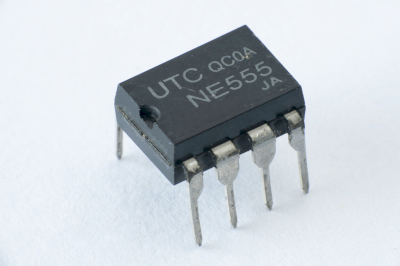What Is a 555 Timer IC?
 A 555 timer IC is commonly used as an oscillator in electronic circuits. It is well-suited for applications such as driving LED displays by supplying fixed-cycle pulses.
A 555 timer IC is commonly used as an oscillator in electronic circuits. It is well-suited for applications such as driving LED displays by supplying fixed-cycle pulses.
The XX555 is a popular variant of the 555 timer IC, with the ‘XX’ prefix varying by manufacturer. It is renowned among digital circuit designers for its reliability and versatility.
Indeed, it is one of the most iconic semiconductors in modern electronics.
Uses of 555 Timer ICs
555 timer ICs are widely used in oscillator circuits within digital systems, providing the main synchronization signal. These fixed-cycle signals are essential for microcontrollers and system controllers to synchronize their operations.
LED display circuits leverage the 555 timer IC for its ability to freely set display durations, making it versatile for various applications.
Furthermore, in digital circuit design, situations often arise where a signal of a fixed period and arbitrary frequency is needed. The 555 timer IC is highly advantageous in such scenarios due to its ease of use and flexibility.
Principles of 555 Timer ICs
The XX555 timer IC primarily comprises three circuits: a window comparator, an RS-flip-flop (RS-FF), and a charge/discharge circuit utilizing capacitors (C) and resistors (R). Its basic operation involves connecting the output of the window comparator to the RS-FF, and then to the charge/discharge circuit through an open collector transistor buffer. This setup creates a feedback loop essential for its functioning.
In the charge/discharge circuit, voltage is applied to the capacitor (C). When the capacitor’s charge reaches a specific voltage, the window comparator activates. As the voltage hits a predetermined level, the comparator’s output switches high, triggering the RS-FF and turning on the transistor buffer. This action initiates the discharge phase. The subsequent discharge causes the comparator’s output to switch low, resetting the RS-FF and resuming the charging phase.
This cyclic operation results in the NOT(Q) output of the RS-FF inverting at a set interval. Consequently, the 555 timer IC’s output (Q) also inverts to sync with NOT(Q).